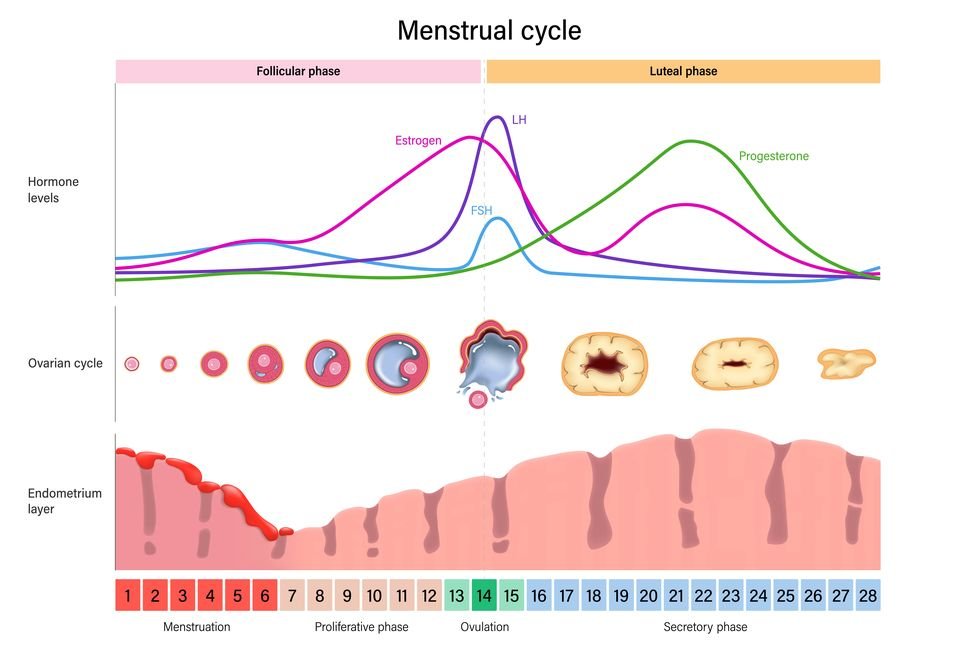How the menstrual cycle works
Women are cyclical creatures by nature in part because of our menstrual cycle. Unlike men, our hormones fluctuate throughout the month and even daily in most cases. Traditionally the menstrual cycle has been associated with the lunar cycles and seasons of the year. Unfortunately, the sacred nature of the menstrual cycle, its rituals and rites of passage from menarche to menopause has become lost in modern society, and as a result, the menstrual cycle has become a mystery and something to be ashamed of or even hated.
One of the reasons so few women let alone men know how the menstrual cycle works is because we’ve been taught that it’s gross and should be suppressed with hormonal birth control or stopped completely. Newsflash— without menstrual cycles, none of us would exist! The reality is knowing how your menstrual cycle works can be very empowering and give women great insight into their fertile window if they’re trying to conceive or avoid pregnancy, if there’s a hormonal imbalance or the subtle (or sometimes not so subtle) energetic changes that occur simultaneously with hormonal shifts throughout one’s cycle. Knowing what’s a normal menstrual cycle for you can also empower you to know when to go to the doctor and when to ignore your doctor when he'/ she says, “that’s normal”, “those symptoms are due to your age,” “there’s no need to do more lab testing", and other BS answers.
Before we get started, there are a few things to know about the menstrual cycle:
Your menstrual cycle is way more than just your period.
Ovulation is the main event in your cycle, because without ovulation progesterone doesn’t get produced.
The “period” you have when taking hormonal birth control is not really menstruation but rather a medicine-induced withdrawal bleed that mimics a real period. Most hormonal birth control methods suppress ovulation which puts women in a chemical menopause.
Period pain and excessive bleeding is NOT normal, so if you’re suffering and hate your period please see a doctor as it could indicate you have an underlying issue like endometriosis, PCOS or fibroids.
PMS is also not normal and indicates a hormonal imbalance(s).
Stress (emotional and physical) can really mess with your hormones and you will notice it especially if you have worse PMS or period symptoms.
Your period is your monthly report card. If you take good care of yourself with a healthy diet, moderate exercise, adequate sleep, stress management and limiting toxin exposure, your hormones will thank you with a menstrual cycle that you can glide through gracefully. If you don’t, your body will let you know. Be grateful you have a monthly report card unlike men so you can course correct before it’s too late.
What are hormones
Hormones are basically chemical messengers that endocrine glands secrete into the bloodstream where they execute various physiological functions to maintain the body’s homeostasis.
Examples include:
Estrogen: produced in the ovaries, adrenal glands and fat tissue; helps develop and maintain reproductive system and plays an important role in bone, cognitive and cardiovascular health. In regards to the menstrual cycle, estrogen (estradiol) stimulates follicle growth, promotes vaginal lubrication, and regulates the flow and thickness of uterine secretions.
Three types of estrogen:
Estradiol: main type of estrogen during a woman’s fertile years
Estriol: most prominent type during pregnancy
Estrone: most present during menopause
Progesterone: produced in a temporary endocrine gland in the ovaries called the corpus luteum and is only produced after ovulation. It’s crucial for a healthy pregnancy because it prepares the uterus for implantation of the embryo and plays an important role in bone and thyroid health and has an anti-anxiety effect.
Testosterone: produced in ovaries and testicles and promotes sex drive, bone and muscle health, fat storage and mental health.
Cortisol: secreted by the adrenal glands, regulates the body’s stress response (physical and emotional) as well as blood sugar and inflammation.
Insulin: secreted by the pancreas and regulates blood sugar levels.
Triiodothyronine (T3): the active thyroid hormone secreted by the thyroid that regulates metabolism.
Melatonin: secreted by the pituitary gland and regulates the circadian rhythm and also serves as a powerful antioxidant.
Phases of the Menstrual Cycle
The menstrual cycle can be divided into three phases— the follicular, Ovulatory, and Luteal Phase. A normal menstrual cycle lasts between 25-35 days with 3-7 days of bleeding, although about 20% of women have irregular cycles. The menstrual cycle occurs thanks to the shift in the hormones follicular stimulating hormone (FSH) and luteinizing hormone which are secreted from the pituitary gland (LH) and estrogen and progesterone which are produced in the ovaries. Therefore, we can say that women are cyclical in nature. Just as our hormones are not at the same level every day, neither is our energy. Our energy and mood shift throughout the month which is a reflection of our hormones.
It’s also important to mention that all of these hormonal fluctuations occur in the brain first. So if you’re having crappy periods or severe PMS, you’re ovaries and uterus may not necessarily be to blame. If you’re undergoing high levels of stress or have high levels of inflammation, your brain will signal to your ovaries that it’s not a good time to pop out an egg that could potentially be fertilized. Since baby making is not the priority, your ovaries will stop producing sufficient estrogen which results in either delayed ovulation or no ovulation. Stress can also affect follicle development which later affects progesterone production in the luteal phase. This topic is for a whole other blog post, but it’s important to keep in mind that the root of your hormonal imbalances might be stress and inflammation, and quick fixes like taking the birth control pill won’t solve your underlying issues unless you address stress management, diet, and lifestyle first.
Menstrual Phase
The first day of your menstrual cycle is technically the first day of your period when your endometrium (uterine lining) sheds. This is also the start of the follicular phase. During menstruation, hormone levels are at their lowest, which is what triggers the shedding of the uterine lining. The uterus also produces the chemical messengers prostaglandins PGF2α and PGE2 which stimulate uterine cramps. So the more prostaglandins you produce, the more menstrual cramps you will have which can also trigger diarrhea. Fun times. Reducing your inflammation via diet and lifestyle can greatly reduce the amount of prostaglandins you produce.
Later, FSH rises which stimulates the maturation of about 3-30 follicles in the ovaries which also produce estrogen. Each follicle contains one egg, and by the end of the folicular phase, only one lucky follicle (or two in the case of twins) gets chosen to continue the maturation process. Ideally the healthiest follicle gets chosen. The rest of the follicles get reabsorbed by the body.
The mature follicle goes on to produce estrogen which stimulates the thickening of the endometrium so that a baby can grow, ideally at least 8mm thick if you’re looking to conceive. This period is also called the Proliferation Phase.
The follicular phase compared to the luteal phase is more variable in length as ovulation is affected by stress and other factors. Basically, if your body doesn’t perceive it’s safe or a good time to pop out an egg and potentially get pregnant, your body will wait to ovulate or you won’t ovulate at all which is called an anovulatory cycle. The average length from day 1 of your period to ovulation is 16 days.
Ovulatory Phase
Ovulation is the main event of the menstrual cycle, not menstruation like many have been taught. Ovulation occurs during one day only maximum; however, the ovulatory phase lasts 16-32 hours when LH rises.
After LH reaches its peak, an egg is released from one of the ovaries and this my friends is what we call ovulation. The egg can only survive for 12-24 hours. If it’s not fertilized it gets absorbed in the body. Around this time due to the surge in estrogen, women notice an increase in libido (because biologically it’s prime time for the egg to get fertilized) and an increase in fertile cervical mucus that’s clear, stretchy, and like egg whites. Some women also experience pain in their lower abdomen usually on the same side as the ovary that releases the egg which is called mittelschmerz (German for middle pain). It doesn’t always occur every month.
Luteal Phase
The follicle that released the egg isn’t finished just yet. It goes on to produce a temporary endocrine gland called the corpus luteum that secretes progesterone as well as estrogen. As I mentioned, no ovulation = no progesterone production = shitty periods, PMS, anxiety, and other unpleasant symptoms.
The corpus luteum is responsible for preparing the uterus for a potential pregnancy by thickening the endometrium, causing the cervical mucus to thicken from an egg white texture to one that’s pasty/ creamy white, and an increase in basal body temperature (this is important to note if you follow Fertility Awareness Method). Progesterone peaks about mid-way through the luteal phase and gradually decreases. Insufficient progesterone production or a quick drop in progesterone mid-cycle can cause PMS symptoms and spotting.
If the egg is not fertilized, the corpus luteum starts to break down which triggers a drop in progesterone and estrogen and eventually the shedding of the endometrium. If you are pregnant, your body should continue to produce sufficient levels of progesterone along with human chorionic gonadotropin (hCG) which is what pregnancy tests detect.
Luteal phase length stays constant from month to month with the occasional change by a day. A healthy luteal phase should last 12-16 days since the corpus luteum cannot survive more than about 16 days.
Signs of a healthy period
Please refer to my previous blog post but the bottom line is that what constitutes as a normal period for you may be slightly different than what’s considered normal and that’s usually ok. What’s NOT normal is suffering through your period and at the end of your menstrual cycle. Your period should come and go without much fanfare. My hope for all women is that their menstrual cycle becomes a source of power, creativity and productivity rather than something we’ve been taught to hate or be ashamed of.



